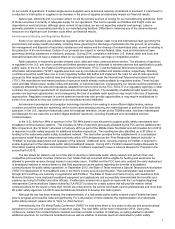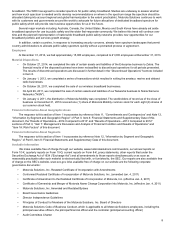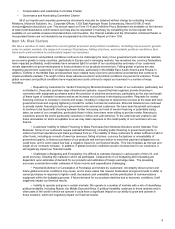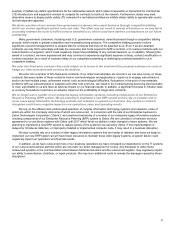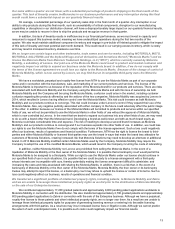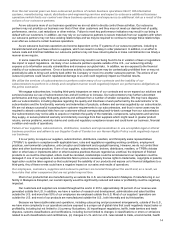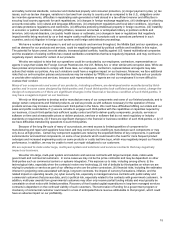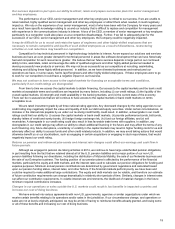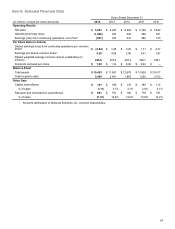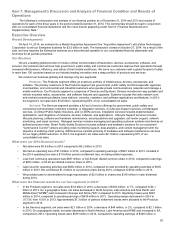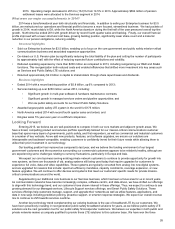Motorola 2014 Annual Report Download - page 19
Download and view the complete annual report
Please find page 19 of the 2014 Motorola annual report below. You can navigate through the pages in the report by either clicking on the pages listed below, or by using the keyword search tool below to find specific information within the annual report.17
In some cases, if the quality issue affects the product's performance, safety or regulatory compliance, then such a
“defective” product may need to be “stop-shipped” or recalled. Depending on the nature of the quality issue and the number of
products in the field, it could cause us to incur substantial recall or corrective field action costs, in addition to the costs
associated with the potential loss of future orders and the damage to our goodwill or brand reputation. In addition, we may be
required, under certain customer contracts, to pay damages for failed performance that might exceed the revenue that we
receive from the contracts. Recalls and field actions involving regulatory non-compliance could also result in fines and additional
costs. Recalls and field actions could result in third-party litigation by persons or companies alleging harm or economic damage
as a result or the use of the products.
We have completed a number of large divestitures over the last several years and have ongoing potential liabilities and
obligations associated with those transactions and the businesses we divested. In addition, these divestitures have
resulted in less diversity of our business and our customer base, which could negatively impact our financial results in
the event of a downturn in our mission-critical communications business.
Over the last several years we have spun-off or sold a number of large businesses, including Motorola Mobility, our
Networks business and our Enterprise business. In connection with our divestitures we typically remain liable for certain pre-
closing liabilities associated with the divested business, such as pension liabilities, taxes, employment, environmental liabilities
and litigation. In the case of the sale of our Enterprise business we agreed to a multi-year non-compete which may limit our
ability to develop and sell products for our commercial customers. In addition, although we often assign contracts associated
with the divested business to a buyer in a divestiture, often that assignment will be subject to the consent of the contractual
counterparty, which may not be obtained or may be conditioned, resulting in the company remaining liable under the contract. In
connection with our divestitures we make representations and warranties and agree to covenants relating to the business
divested. We remain liable for a period of time for breaches of representations, warranties and covenants and we also indemnify
buyers in the event of such breaches and for other specific risks. Even though we establish reserves for any expected ongoing
liability associated with divested businesses, those reserves may not be sufficient if unexpected liabilities arise and this could
negatively impact our financial condition and future results of operations.
Because we are now singularly focused on mission-critical communications for public safety and commercial customers we
have less diversity in our business and our customer base. A downturn in this business could have a greater negative impact on
our financial results than when we were a more diversified communications provider.
We expect to continue to make strategic acquisitions of other companies or businesses and these acquisitions
introduce significant risks and uncertainties, including risks related to integrating the acquired businesses and
achieving benefits from the acquisitions.
In order to position ourselves to take advantage of growth opportunities or to meet other strategic needs such as product or
technology gaps, we have made, and expect to continue to make, strategic acquisitions that involve significant risks and
uncertainties. These risks and uncertainties include: (i) the difficulty or inability in integrating newly-acquired businesses and
operations in an efficient and effective manner, particularly in light of the fact that certain of our enterprise legacy information
systems including components of our ERP system are owned by Zebra and we are unable to make significant changes to these
systems until completion of our new ERP implementation, (ii) risks associated with integrating financial reporting and internal
control systems, particularly in light of the ERP system changes, (iii) the challenges in achieving strategic objectives, cost
savings and other benefits from acquisitions, (iv) the risk that our markets do not evolve as anticipated and that the technologies
acquired do not prove to be those needed to be successful in those markets, (v) the potential loss of key employees of the
acquired businesses, (vi) the risk of diverting the attention of senior management from our operations, (vii) the risks of entering
new markets in which we have limited experience, (viii) difficulties in integrating information technology systems and other
business processes to accommodate the acquired businesses and (ix) future impairments of goodwill of an acquired business.
In particular, failure to achieve targeted cost and revenue synergies could negatively impact our business performance.
Certain acquisition candidates in the industries in which we participate may carry higher relative valuations (based on
revenues, earnings, cash flow, or other relevant multiples) than we do. This is particularly evident in software and certain
services businesses. Acquiring a business that has a higher relative valuation than Motorola Solutions may be dilutive to our
earnings. In addition, we may not pursue opportunities that are highly dilutive to near-term earnings.
Key employees of acquired businesses may receive substantial value in connection with a transaction in the form of cash
payments for their ownership interest, particularly in the case of founders, change-in-control agreements, acceleration of stock
options and the lifting of restrictions on other equity-based compensation rights. To retain such employees and integrate the
acquired business, we may offer additional retention incentives, but it may still be difficult to retain certain key employees.
We face many risks relating to intellectual property rights.
Our business will be harmed if: (i) we, our customers and/or our suppliers are found to have infringed intellectual property
rights of third-parties, (ii) the intellectual property indemnities in our supplier agreements are inadequate to cover damages and
losses due to infringement of third-party intellectual property rights by supplier products, (iii) we are required to provide broad
intellectual property indemnities to our customers, (iv) our intellectual property protection is inadequate to protect against threats
of misappropriation from internal or external sources or otherwise inadequate to protect our proprietary rights, or (v) our
competitors negotiate significantly more favorable terms for licensed intellectual property. We may be harmed if we are forced to
make publicly available, under the relevant open-source licenses, certain internally developed software-related intellectual
property as a result of either our use of open-source software code or the use of third-party software that contains open-source
code.


